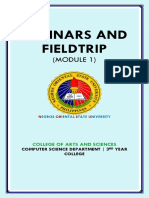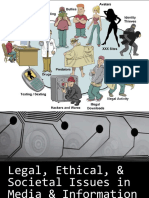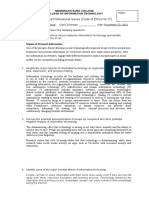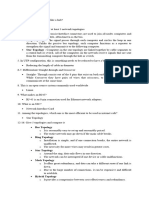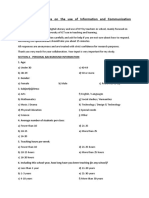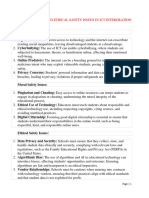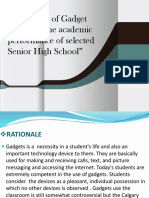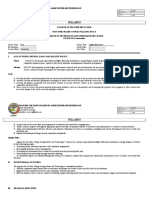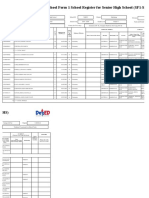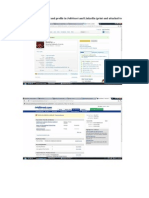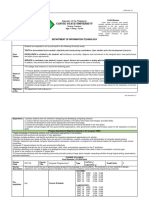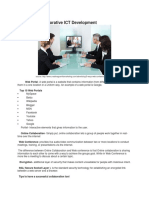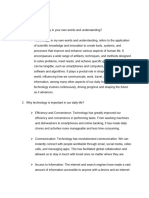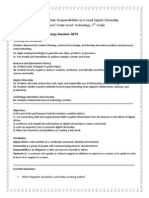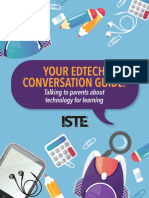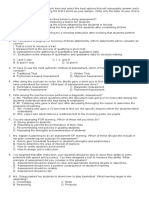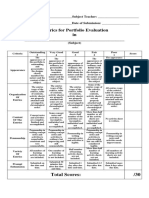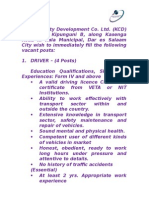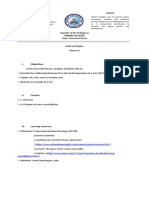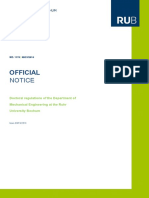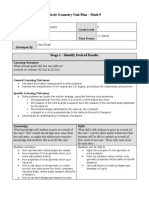Digital Citizenship
Digital Citizenship
Uploaded by
api-249448483Copyright:
Available Formats
Digital Citizenship
Digital Citizenship
Uploaded by
api-249448483Original Title
Copyright
Available Formats
Share this document
Read this document in other languages
Did you find this document useful?
Is this content inappropriate?
Copyright:
Available Formats
Digital Citizenship
Digital Citizenship
Uploaded by
api-249448483Copyright:
Available Formats
Title of Unit Digital Citizenship Grade Level 4
th
Grade
Stage 2 Determine Acceptable Evidence
1. Creativity and Innovation: Students demonstrate creative thinking, construct knowledge and
develop innovative products and processes using technology.
2. Communication and Collaboration: Students will interact, collaborate and publish with peers
employing a variety of digital environments and media.
5. Digital Citizenship: Students exhibit a positive attitude toward using technology that supports
collaboration, learning and productivity. Students will advocate and practice safe, legal, and
responsible use of information and technology.
Essential Questions
Overarching Questions:
1. How has technology changed the way
people interact with the world around
them?
2. What kind of power does the Internet give
us?
Topical Questions:
1. What are the rules and consequences of
digital citizenship?
2. What is the importance of promoting the
concept of digital citizenship and the common
good?
Stage 2 - Evidence
Performance Tasks
Task 1: Digital Superhero (Application)
Goal: Your task is to create a digital superhero that exhibits exemplary
attributes and are able to solve dilemmas in a responsible way.
Role: You are a cartoon designer.
Audience: The target audience is your peers.
Situation: The challenge involves creating appropriate digital
superheroes for the target audience.
Product Performance and Purpose: You will design and create a
superhero along with a digital scenario that solves a dilemma in a
responsible way. You may choose the design and layout for your
superhero and scenario. You will showcase your product in the media
center for the class to view.
Standards and Criteria for Success: Your product must meet the
following standards:
Illustrations and appropriate vocabulary for the intended target
audience
Explanation of simple machines and uses in detail
Correct grammar/punctuation.
Other Evidence
Informal Checks
o The teacher uses a dipstick check by asking, How well do you feel you know the
information? Students respond by indicating a number from one (1) to five (5); 5 I know
it so well I can teach it; 4 I can do it alone; 3 I need some help; 2 I could use more
practice; 1 I am only beginning. (Self-Knowledge)
Tests/Quizzes
o Teacher uses selected responses (e.g., multiple choice, true/false, matching) or short answer
formats
o Tests (Self-Knowledge)
Academic Prompts
o Teacher assesses students knowledge of digital citizenship by asking students to explain
what kind of power the Internet gives us. (Explanation)
o Teacher shows the students a three-column chart with the terms Safe, Responsible,
and Respectful written at the top of each column. Invite students to shout out
words or phrases that describe how people can act safely, responsibly, and
respectfully online, and then write them in the appropriate column. (Alternatively,
have students write their words or phrases on sticky notes and post them on the
chart.) (Explanation)
Observations/Dialogue
o Teacher utilizes think/pair/share to assess students understanding of digital citizenship by
asking scenario type questions: (Perspective)
-Is it legal to use anything from the Internet, anyway you want, unless it says you have to purchase
it?
-Have you ever received/sent an upsetting text message or email from someone who acted like they
knew you but didnt identify themselves?
- Have you ever posted information, like your telephone number, your email, the name of your
school, your sports team, etc. online?
-Do you think your parents are too strict about what you post online?
The Following Essential Questions Should Be Addressed:
o What are the rules and consequences of digital citizenship?
o What is the importance of promoting the concept of digital citizenship and the common
good?
o How do you stay safe online and off?
Move from group to group, noting students who demonstrate understanding and those who do not during
lessons and performance tasks.
Learning Logs/Journals
- Writing Prompts (Answer E.Q.s)
1. What are the rules and consequences of digital citizenship?
2. What is the importance of promoting the concept of digital citizenship and the common good?
-Create a mind map using the web 2.0-tool, Popplet, of the rules and consequences of digital
citizenship.
or
Students can create a wordle that incorporates words associated with the rules and consequences of
digital citizenship.
(Differentiation)
Students collaborate in pairs and small groups whose membership changes as needed. Learning
in groups enables students to engage in meaningful discussions and to observe and learn from
one another.
Student Self-Assessment and Reflection
Name________________________________________Date___________________________
Today, I learned______________________________________________________________
___________________________________________________________________________
___________________________________________________________________________
___________________________________________________________________________
I did well ___________________________________________________________________
___________________________________________________________________________
___________________________________________________________________________
___________________________________________________________________________
I am still confused ____________________________________________________________
___________________________________________________________________________
___________________________________________________________________________
___________________________________________________________________________
I need help with ______________________________________________________________
___________________________________________________________________________
___________________________________________________________________________
___________________________________________________________________________
I want to know more about_____________________________________________________
___________________________________________________________________________
___________________________________________________________________________
___________________________________________________________________________
Next time, I will work on ______________________________________________________
___________________________________________________________________________
___________________________________________________________________________
___________________________________________________________________________
Rubric
The Performance Tasks incorporates the six facets of understanding to generate possible ways in which students might
reveal understanding.
Task 1: Digital Superhero (Application)
Goal: Your task is to create a digital superhero that exhibits exemplary attributes and are able to solve dilemmas in a responsible
way.
Role: You are a cartoon designer.
Audience: The target audience is your peers.
Situation: The challenge involves creating appropriate digital superheroes for the target audience.
Product Performance and Purpose: You will design and create a superhero along with a digital scenario that solves a dilemma in
a responsible way. You may choose the design and layout for your superhero and scenario. You will showcase your product in
the media center for the class to view.
Standards and Criteria for Success: Your product must meet the following standards:
Illustrations and appropriate vocabulary for the intended target audience
Explanation of simple machines and uses in detail
Correct grammar/punctuation
Rubric for Performance Task 1
Category Exceeds: 3 points Target: 2 points Unacceptable: 1 point Your Score
Content All content throughout
the presentation is
accurate. There are no
factual errors.
Most of the content is
accurate but there is one
piece of information that
might be inaccurate.
Content is typically
confusing or contains
more than one factual
error.
_____/3
Sequencing of
Information
Information is organized
in a clear, logical way. It
is easy to anticipate the
type of material that
might be on the next
card.
Most information is
organized in a clear,
logical way. One card or
item of information
seems out of place.
There is no clear plan
for the organization of
information.
_____/3
Effectiveness Project includes all
material needed to gain
a comfortable
understanding of the
topic. It is a highly
effective study guide.
Project includes most
material needed to gain
a comfortable
understanding of the
material but is lacking
one or two key
elements. It is an
adequate study guide.
Project is lacking
several key elements
and has inaccuracies that
make it a poor study
guide.
_____/3
Spelling and Punctuation There are no spelling or
punctuation errors in the
final draft. Character
and place names that the
author invented are
spelled consistently
throughout.
There is one spelling or
punctuation error in the
final draft.
The final draft has more
than 3 spelling and
punctuation errors.
_____/3
_____/12 Points Possible Final Grade____________
Lesson Plans
Day 1 & Day 2 Day 3 Day 4 Day 5
Standard: NETS 1, 2, 5
E.Q. What are the rules
and consequences of
digital citizenship?
Activity: Finish previous
days activity.
Closing: INVITE students
to introduce their
superheroes to one
another.
Assessment: Should be
determined by
completed superheroes
with qualities listed.
Standard: NETS 1, 2,
E.Q. What is the
importance of promoting
the concept of digital
citizenship and the
common good?
Activity: REMIND
students how good
digital citizens can
harness the power of
digital media to make the
world a better place.
TELL students to
complete Step 2 of the
Save the Day! Student
Handout, which prompts
them to create a short,
three-frame comic strip.
They should illustrate a
problem in the digital
world, and how their
digital superhero helps
resolve that digital
dilemma. Students can
create comic strips
freehand on the handout
using illustrations,
speech bubbles, and
captions. Or,
alternatively, they can
use an online tool, such
as Make Beliefs Comix or
Comic Life (Mac, must
purchase). SHARE one or
two of the following
examples, if students
need guidance creating a
scenario:
Someone spreads rumors
about somebody else
online.
Someone cheats on an
assignment for school by
copying information from
a website and saying
they wrote it.
Someone uses someone
elses password to
pretend to be that
person online.
Someone says mean
things online.
Someone forwards a
message containing
private information to
someone else.
DISPLAY your students
comics around the
classroom, like in an art
gallery. Then have
students take a gallery
Standard: NETS 1, 2, 5
E.Q. How has technology changed the way people interact with the
world around them?
What kind of power does the Internet give us? What are the rules
and consequences of digital citizenship?
Activity:
First, pre-assess students knowledge of digital citizenship using
brainpops digitial citizenship quiz:
http://www.brainpop.com/spotlight/digitalcitizenship/
Introduce students to Spider Mans motto, With great power
comes great responsibility. Guide students to recognize that the
things we read, see, and hear online can lead people to have all
sorts of feelings (e.g., happy, hurt, excited, angry, curious). Students
do a think pair share and brainstorm ideas on what power the
Internet gives to people. Have children understand that what we
do and say online can be powerful. The Internet also allows us to
learn about anything, talk to people at any time (no matter where
they are in the world), and share our knowledge and creative
projects with other people.
Have students create a mind map or wordle to assess their
understanding of what they feel are rules and consequences of
digital citizenship.
Closing: Students share their mind maps and/or wordles and point
out why they made reference to certain words.
Assessment: Should be determined by completed mind maps and
wordles. Review data from pre-assessment on digital citizenship.
Standard: NETS 1, 2, 5
E.Q. What are the rules and
consequences of digital
citizenship?
Activity:
DEFINE the Key Vocabulary
term digital citizen.
Emphasize that a digital
citizen is more than just an
Internet user. Its someone
who chooses to act in a safe,
respectful, and responsible
way online. CREATE a three-
column chart with the terms
Safe, Responsible, and
Respectful written at the
top of each column. Invite
students to shout out words
or phrases that describe
how people can act safely,
responsibly, and respectfully
online, and then write them
in the appropriate column.
(Alternatively, have students
write their words or phrases
on sticky notes and post
them on the chart.)
DISTRIBUTE the Save the
Day! Student Handout to
each student. (Optional:
Students can also create
superheroes online using
Marvels Create Your Own
Superhero.) TELL students to
complete Step 1, which
prompts them to create a
superhero for the digital
world. Encourage them to
ask themselves the
following:
What kind of superpowers
would my digital citizen
superhero use to help others
act safely, responsibly,
respectfully online? What is
special about the way my
superhero acts and thinks?
What kind of special
costume would my
superhero wear to help him
or her do the job?
What would my superheros
name be? (for example,
Dynamic Digital Dave or
The Upstander).
REMIND students to note
some of their superheros
unique qualities.
Closing: INVITE students to
introduce their superheroes
to one another.
Assessment: Should be
determined by completed
superheroes with qualities
listed.
walk, whether as a class
or in small groups. Allow
each student the
opportunity to describe
his or her comic to
others.
Closing: Students share
their comics.
Assessment: Should be
determined by
completed comic strips.
Re-assess students on
digital citizenship from
brainpop and assess
data.
SIX SIMPLE MACHINES
Field Trip Destinations: Visit these Web sites with your partner to complete the
graphic organizer.
Dirtmeister's Science Reporters: Simple Machines
http://teacher.scholastic.com/dirtrep/simple/index.htm
Inventor's Toolbox: The Elements of Machines
http://www.mos.org/sln/Leonardo/InventorsToolbox.html
Edheads: Simple Machines Activities http://www.edheads.org/activities/simple-
machines/index.htm
InQuiry Almanack: Simple Machines http://www.fi.edu/qa97/spotlight3/spotlight3.html
MIKIDS: Simple Machines http://www.mikids.com/Smachines.htm
Canada Science and Technology Museum: Simple Machines
http://www.sciencetech.technomuses.ca/english/schoolzone/Info_Simple_Machines2.cfm
Name of Simple
Machine
1. 2. 3.
Diagram
Describe how it
works
Name of simple
machine
4. 5. 6.
Diagram
Describe how it
works
SIX SIMPLE MACHINES
With your partner, locate information to answer these questions on
your Internet Field Trip, then discuss and answer these focus
questions about simple machines.
Why do we use machines?
When you're discussing simple
machines, what do the terms
"work," "effort," and "force"
mean?
How do machines make our
work easier?
When you combine simple
machines, what do you get?
Cite two examples.
You might also like
- MIL WK 3Document16 pagesMIL WK 3Mebet MoralesNo ratings yet
- Seminars and Fieldtrip: (Module 1)Document11 pagesSeminars and Fieldtrip: (Module 1)Aeign NashNo ratings yet
- Weekly Home Learning Plan: Puti-An National High SchoolDocument2 pagesWeekly Home Learning Plan: Puti-An National High SchoolNoli FriasNo ratings yet
- PPTDocument59 pagesPPTsairam saiNo ratings yet
- Legal Ethical and Sociaetal Issues PDFDocument67 pagesLegal Ethical and Sociaetal Issues PDFjonnefer masangyaNo ratings yet
- ICT Tools-2Document11 pagesICT Tools-2ivymacalma09No ratings yet
- Exam in Social and Professional Issues Code of Ethics For IT DoneDocument2 pagesExam in Social and Professional Issues Code of Ethics For IT DoneWilliam Rosal0% (1)
- ICT - Computer Programming NC IV 20151119Document20 pagesICT - Computer Programming NC IV 20151119Danz Tag0% (1)
- Computers and SocietyDocument2 pagesComputers and SocietyDahouiNo ratings yet
- Monday Tuesday Wednesday Thursday Friday: I. ObjectivesDocument2 pagesMonday Tuesday Wednesday Thursday Friday: I. ObjectivesReynald ManzanoNo ratings yet
- Lesson 3-Trends in IctDocument13 pagesLesson 3-Trends in IctRyan TusalimNo ratings yet
- QUIZDocument2 pagesQUIZKurt Audrey Delute MonteraNo ratings yet
- 3 Teacher Questionnaire On The Use of ICTDocument6 pages3 Teacher Questionnaire On The Use of ICTMonica San JuanNo ratings yet
- L1a Introduction To Information and Communication TechnologyDocument65 pagesL1a Introduction To Information and Communication TechnologyDaniel Fancis Amabran Barrientos100% (1)
- Notes For Ict IntergrationDocument13 pagesNotes For Ict Intergrationbennjahh649No ratings yet
- Maindang Nationl High SchoolDocument2 pagesMaindang Nationl High SchoolJayram JavierNo ratings yet
- Mechanics and Criteria For Spoken Word and Vlogging ContestsDocument2 pagesMechanics and Criteria For Spoken Word and Vlogging ContestsErwil AgbonNo ratings yet
- Etech Etech Etech 2Document4 pagesEtech Etech Etech 2Neil MirandaNo ratings yet
- Etech Summative Test2 Online PlatformsDocument1 pageEtech Summative Test2 Online PlatformsRingk KringNo ratings yet
- Unit 1.2 Ethical & Social Issues in ICTDocument19 pagesUnit 1.2 Ethical & Social Issues in ICTSiddhartha DahalNo ratings yet
- Lesson Plan in PPT ChartDocument4 pagesLesson Plan in PPT ChartRosalyn AustriaNo ratings yet
- EmTech Module - Q1 by Grascia - 4Document15 pagesEmTech Module - Q1 by Grascia - 4gRascia OnaNo ratings yet
- Course Outline Living in IT EraDocument1 pageCourse Outline Living in IT EramikeNo ratings yet
- Book 8 - Unit 3 - JengDocument12 pagesBook 8 - Unit 3 - JengFernandez JainardNo ratings yet
- History of Information Technology: Lesson 1Document4 pagesHistory of Information Technology: Lesson 1Almira Legion PisngotNo ratings yet
- Frequency of Gadget Usage and The Academic Performance of Selected Senior High SchoolDocument16 pagesFrequency of Gadget Usage and The Academic Performance of Selected Senior High SchoolHii Reis HerisNo ratings yet
- Digital Citizenship: Unit 13Document13 pagesDigital Citizenship: Unit 13John Lloyd BalinasNo ratings yet
- Teacher's GuideDocument72 pagesTeacher's GuideJenny ANo ratings yet
- Software Engineering Module 1Document34 pagesSoftware Engineering Module 1amant0% (1)
- COIT 403 Course Contents in Integrative Programming Technologies PDFDocument3 pagesCOIT 403 Course Contents in Integrative Programming Technologies PDFAaron Jude PaelNo ratings yet
- TEC 255 - Introduction To ICT (Specialization 2)Document11 pagesTEC 255 - Introduction To ICT (Specialization 2)Princess Ira SantillanNo ratings yet
- Positive and Negative Impacts of Computer AssignmentDocument3 pagesPositive and Negative Impacts of Computer AssignmentM Hasse Khan50% (2)
- Syllabus Digital Electronics - IA 6Document14 pagesSyllabus Digital Electronics - IA 6rendez vousNo ratings yet
- School Form 1 School Register For Senior High School (SF1-SHS)Document4 pagesSchool Form 1 School Register For Senior High School (SF1-SHS)Kay Tracey UrbiztondoNo ratings yet
- Action Research Titles For IctDocument1 pageAction Research Titles For IctAlex Dee Music HubNo ratings yet
- Current and Future Trends in Media and InformationDocument4 pagesCurrent and Future Trends in Media and InformationCristopher Baltar100% (1)
- Empowerment TechnologiesDocument3 pagesEmpowerment TechnologiesStephany Bryan Diez ItaoNo ratings yet
- It201-Human Computer Interaction - CaloDocument14 pagesIt201-Human Computer Interaction - CaloJudielyn CualbarNo ratings yet
- Jobstreet Case StudyDocument9 pagesJobstreet Case StudyHeidy LeeNo ratings yet
- Kto12TLE-ICT Computer Hardware ServicingDocument79 pagesKto12TLE-ICT Computer Hardware ServicingDynalyn Espares50% (2)
- Module 1 - Introduction To Computer NetworksDocument9 pagesModule 1 - Introduction To Computer NetworksJohn Paul Alcantara NidoyNo ratings yet
- DCIT22 Course SyllabusDocument10 pagesDCIT22 Course SyllabusSofia RodriguezNo ratings yet
- A Lesson Plan in Mil 3Document2 pagesA Lesson Plan in Mil 3HappyNeversmilesNo ratings yet
- Media and Information Literacy: Quarter 2: Week 2 Learning Activity SheetsDocument9 pagesMedia and Information Literacy: Quarter 2: Week 2 Learning Activity SheetsWilson Dela CruzNo ratings yet
- PRE-TEST Empowerment TechnologyDocument40 pagesPRE-TEST Empowerment TechnologyMat3xNo ratings yet
- Review QuestionsDocument35 pagesReview QuestionsNoel Butawan CabañaNo ratings yet
- Lesson 9 EMPOWERMENTDocument2 pagesLesson 9 EMPOWERMENTMonday VerdejoNo ratings yet
- Power of Social Media - PPT - Aryan VedapathakDocument14 pagesPower of Social Media - PPT - Aryan VedapathakShubhashriNo ratings yet
- 1.1 Fill in The Blanks in Each of The FollowingDocument3 pages1.1 Fill in The Blanks in Each of The FollowingMuhammad Mahadi HasanNo ratings yet
- Lesson Plan - Unit No. 1 - Lesson No. 1 Grade 4Document4 pagesLesson Plan - Unit No. 1 - Lesson No. 1 Grade 4Jenold ParaisoNo ratings yet
- Living in IT EraDocument7 pagesLiving in IT EraKim Elfa CabalteraNo ratings yet
- Lesson Plan MIL COR11Document81 pagesLesson Plan MIL COR11NANCITA O. PERLASNo ratings yet
- What Is Interaction Design?Document48 pagesWhat Is Interaction Design?SNTCC107CHAITANYA6826No ratings yet
- TTL 2 Lesson1 and Lesson2Document7 pagesTTL 2 Lesson1 and Lesson2HazeldiazasenasNo ratings yet
- Topic/Lesson Name Content Standards Performance Standards Learning Competencies Specific Learning Outcomes Time Allotment Materials ResourcesDocument4 pagesTopic/Lesson Name Content Standards Performance Standards Learning Competencies Specific Learning Outcomes Time Allotment Materials Resourcesrhiantics_kram11No ratings yet
- 01 - Software Engineering - II (Course Outline)Document4 pages01 - Software Engineering - II (Course Outline)Junaid ArshadNo ratings yet
- 1.MIL 1. Introduction To MIL (Part 2) - Characteristics of Information Literate Individual and Importance of MILDocument2 pages1.MIL 1. Introduction To MIL (Part 2) - Characteristics of Information Literate Individual and Importance of MILCha Gao-ay50% (2)
- DLL Mail Merge WordDocument5 pagesDLL Mail Merge WordCHARLENE SAGUINHONNo ratings yet
- Jan 27 Performance TaskDocument6 pagesJan 27 Performance Taskapi-236919970No ratings yet
- Iste Edtech ConversationDocument6 pagesIste Edtech Conversationapi-512161219No ratings yet
- DLL - English 3 - Q4 - W4Document3 pagesDLL - English 3 - Q4 - W4marketing dvcNo ratings yet
- HTML Website: Submitted byDocument15 pagesHTML Website: Submitted byDeepanshi Ahuja0% (1)
- Individual Differences in l2 AcquisitionDocument12 pagesIndividual Differences in l2 Acquisitionwindi nurainiNo ratings yet
- Value Education Course OutlineDocument3 pagesValue Education Course Outlineamishachandravanshi17No ratings yet
- Matrik Penelitian: Sekolah Inggris?Document2 pagesMatrik Penelitian: Sekolah Inggris?Kharisma Karunia IlahiNo ratings yet
- Annotated Bib FinalDocument8 pagesAnnotated Bib Finalapi-509265643No ratings yet
- Pnu-Assessment QuestionsDocument6 pagesPnu-Assessment QuestionsRosemarie CunananNo ratings yet
- Rubric For Portfolio Evaluation (Updated)Document1 pageRubric For Portfolio Evaluation (Updated)Daniella Daniella67% (3)
- Per Policy eDocument6 pagesPer Policy esamiNo ratings yet
- Kasenga City Development Company Limited Vacancies AnnouncementDocument12 pagesKasenga City Development Company Limited Vacancies AnnouncementMuhidin Issa MichuziNo ratings yet
- Educational Impact of Gender Related Pashto ProverbsDocument11 pagesEducational Impact of Gender Related Pashto ProverbsDr. Muhammad Ali DinakhelNo ratings yet
- Module 8. Learningthinking StylesDocument4 pagesModule 8. Learningthinking StylesjelmerpadawagNo ratings yet
- 10 Movement Lesson IdeasDocument6 pages10 Movement Lesson Ideasapi-645825116No ratings yet
- Math DLLDocument5 pagesMath DLLDeane jewel BuenavistaNo ratings yet
- I. Objectives: Mabini CollegesDocument4 pagesI. Objectives: Mabini CollegesMyla RicamaraNo ratings yet
- Ab1178 de enDocument16 pagesAb1178 de envivekpattniNo ratings yet
- JNV Instructions FcsaDocument4 pagesJNV Instructions Fcsamayuresh kumarNo ratings yet
- Personal and Professional Development Sample by Instant Essay WritingDocument18 pagesPersonal and Professional Development Sample by Instant Essay WritingInstant Essay WritingNo ratings yet
- Walsh, S. (2006)Document10 pagesWalsh, S. (2006)ratu erlindaNo ratings yet
- Syllabus: English For Project Management: Conversation Essentials 1Document4 pagesSyllabus: English For Project Management: Conversation Essentials 1Mary VargasNo ratings yet
- Challenges Faced by Postgraduate Students: A Case Study of A Private University in PakistanDocument8 pagesChallenges Faced by Postgraduate Students: A Case Study of A Private University in PakistanIqra SharifNo ratings yet
- Core Assignment Eeu 325Document3 pagesCore Assignment Eeu 325api-355958411No ratings yet
- Online Feedback Collection SystemDocument23 pagesOnline Feedback Collection Systempkrmms100% (1)
- JKR PDFDocument1 pageJKR PDFafnan hamimiNo ratings yet
- Engineering Rubric For SO (E) Modern Tool UsageDocument1 pageEngineering Rubric For SO (E) Modern Tool UsageDaniel Bobis100% (1)
- Habitat-Adaptation LessonDocument9 pagesHabitat-Adaptation Lessonapi-270058879No ratings yet
- Math 9 Circle Geometry Unit PlanDocument25 pagesMath 9 Circle Geometry Unit Planapi-503273730No ratings yet
- LLB Bachelor of Laws University of LondonDocument1 pageLLB Bachelor of Laws University of Londondenmarklewis17No ratings yet
- My Choice Unisa 2013 Application FormDocument8 pagesMy Choice Unisa 2013 Application Formengsam777No ratings yet
- Lesson Plan - UDL HighlightsDocument3 pagesLesson Plan - UDL Highlightsjfisher1No ratings yet

